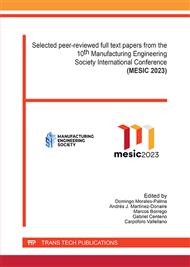[1]
E. Marino, L. Barbieri, B. Colacino, A. K. Fleri, and F. Bruno, "An Augmented Reality inspection tool to support workers in Industry 4.0 environments," Comput. Ind., vol. 127, p.103412, May 2021.
DOI: 10.1016/j.compind.2021.103412
Google Scholar
[2]
P. T. Ho, J. A. Albajez, J. Santolaria, and J. A. Yagüe-Fabra, "Study of Augmented Reality Based Manufacturing for Further Integration of Quality Control 4.0: A Systematic Literature Review," Appl. Sci., vol. 12, no. 4, p.1961, Feb. 2022.
DOI: 10.3390/app12041961
Google Scholar
[3]
O. Danielsson, M. Holm, and A. Syberfeldt, "Augmented reality smart glasses for operators in production: Survey of relevant categories for supporting operators," Procedia CIRP, vol. 93, p.1298–1303, 2020.
DOI: 10.1016/j.procir.2020.04.099
Google Scholar
[4]
Z. Wang et al., "A comprehensive review of augmented reality-based instruction in manual assembly, training and repair," Robot. Comput. Integr. Manuf., vol. 78, p.102407, Dec. 2022.
Google Scholar
[5]
D. H. Shin and P. S. Dunston, "Identification of application areas for Augmented Reality in industrial construction based on technology suitability," Autom. Constr., vol. 17, no. 7, p.882–894, Oct. 2008.
DOI: 10.1016/j.autcon.2008.02.012
Google Scholar
[6]
W. Gomberg, H. B. Maynard, G. J. Stegemerten, and J. L. Schwab, "Methods-Time Measurement.," Ind. Labor Relations Rev., vol. 2, no. 3, p.456, Apr. 1949.
DOI: 10.2307/2519095
Google Scholar
[7]
A. Y. C. Nee, S. K. Ong, G. Chryssolouris, and D. Mourtzis, "Augmented reality applications in design and manufacturing," CIRP Ann., vol. 61, no. 2, p.657–679, 2012.
DOI: 10.1016/j.cirp.2012.05.010
Google Scholar
[8]
A. Y. C. Nee and S. K. Ong, Eds., Springer Handbook of Augmented Reality. Cham: Springer International Publishing, 2023.
Google Scholar
[9]
V. Stich and M. Blum, "A Cybernetic Reference Model for Production Systems Using the Viable System Model," vol. 459, S. Umeda, M. Nakano, H. Mizuyama, N. Hibino, D. Kiritsis, and G. von Cieminski, Eds. Cham: Springer International Publishing, 2015, p.169–176.
Google Scholar
[10]
V. Gorobets, V. Holzwarth, C. Hirt, N. Jufer, and A. Kunz, "A VR-based approach in conducting MTM for manual workplaces," Int. J. Adv. Manuf. Technol., vol. 117, no. 7–8, p.2501–2510, Dec. 2021.
DOI: 10.1007/s00170-021-07260-7
Google Scholar
[11]
X. Wang, A. W. W. Yew, S. K. Ong, and A. Y. C. Nee, "Enhancing smart shop floor management with ubiquitous augmented reality," Int. J. Prod. Res., vol. 58, no. 8, p.2352–2367, Apr. 2020.
DOI: 10.1080/00207543.2019.1629667
Google Scholar
[12]
M. Holm, O. Danielsson, A. Syberfeldt, P. Moore, and L. Wang, "Adaptive instructions to novice shop-floor operators using Augmented Reality," J. Ind. Prod. Eng., vol. 34, no. 5, p.362–374, Jul. 2017.
DOI: 10.1080/21681015.2017.1320592
Google Scholar
[13]
J. Zhou, I. Lee, B. Thomas, R. Menassa, A. Farrant, and A. Sansome, "Applying spatial augmented reality to facilitate in-situ support for automotive spot welding inspection," in Proceedings of the 10th International Conference on Virtual Reality Continuum and Its Applications in Industry - VRCAI '11, 2011, p.195–200.
DOI: 10.1145/2087756.2087784
Google Scholar
[14]
E. Tzimas, G.-C. Vosniakos, and E. Matsas, "Machine tool setup instructions in the smart factory using augmented reality: a system construction perspective," Int. J. Interact. Des. Manuf., vol. 13, no. 1, p.121–136, Mar. 2019.
DOI: 10.1007/s12008-018-0470-z
Google Scholar
[15]
D. L. Goodhue and R. L. Thompson, "Task-Technology Fit and Individual Performance," MIS Q., vol. 19, no. 2, p.213, Jun. 1995.
DOI: 10.2307/249689
Google Scholar
[16]
N. Vendramin, G. Nardelli, and C. Ipsen, "Task-Technology Fit Theory," in A Handbook of Theories on Designing Alignment between People and the Office Environment, London: Routledge, 2021, p.39–53.
DOI: 10.1201/9781003128830-4
Google Scholar
[17]
N. Vaidyanathan, "Augmented Reality Technologies Selection Using the Task-Technology Fit Model – A Study with ICETS," 2020, p.654–663.
DOI: 10.1007/978-3-030-45691-7_61
Google Scholar
[18]
P. Kuhlang, S. Hempen, W. Sihn, and J. Deuse, "Systematic improvement of value streams - fundamentals of value stream oriented process management," Int. J. Product. Qual. Manag., vol. 12, no. 1, p.1, 2013.
DOI: 10.1504/ijpqm.2013.054860
Google Scholar
[19]
K. Heinz and R. Olbrich, Planzeitermittlung. Hanser, 1994.
Google Scholar
[20]
A. Bellarbi, J.-P. Jessel, and L. Da Dalto, "Towards Method Time Measurement Identification Using Virtual Reality and Gesture Recognition," in 2019 IEEE International Conference on Artificial Intelligence and Virtual Reality (AIVR), Dec. 2019, p.191–1913.
DOI: 10.1109/aivr46125.2019.00040
Google Scholar
[21]
A. Mertens and C. M. Schlick, "Modeling and optimizing manual work processes with MTM," in Industrial Engineering and Ergonomics, Aachen: RWTH Aachen University, 2017, p.20.
Google Scholar
[22]
X. Wang, S. K. Ong, and A. Y. C. Nee, "A comprehensive survey of augmented reality assembly research," Adv. Manuf., vol. 4, no. 1, p.1–22, Mar. 2016.
DOI: 10.1007/s40436-015-0131-4
Google Scholar
[23]
R. Radkowski, "Investigation of Visual Features for Augmented Reality Assembly Assistance," 2015, p.488–498.
Google Scholar
[24]
J. Koch, L. Büsch, M. Gomse, and T. Schüppstuhl, "A Methods-Time-Measurement based Approach to enable Action Recognition for Multi-Variant Assembly in Human-Robot Collaboration," Procedia CIRP, vol. 106, p.233–238, 2022.
DOI: 10.1016/j.procir.2022.02.184
Google Scholar



